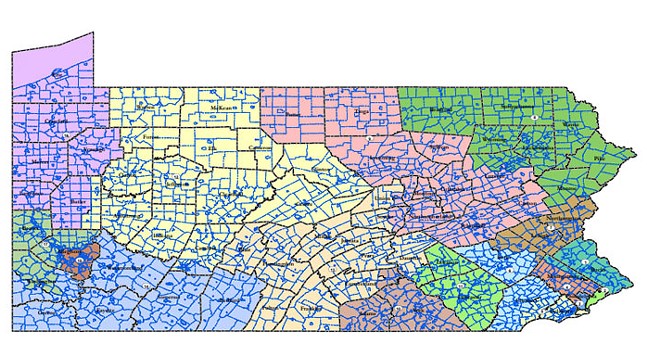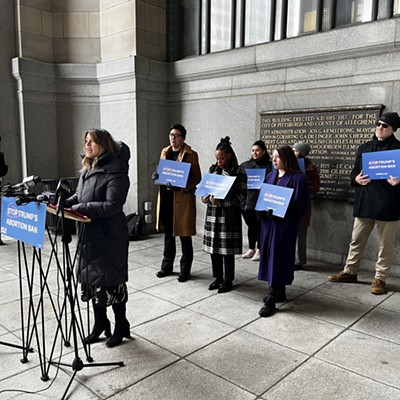But Wolf has already expressed his opposition, calling the map “highly skewed” in a December letter to the General Assembly, which means it likely will fall to the state courts to divide Pennsylvania into 17 new congressional districts to match shifting populations.
“It just comes down to we can’t agree,” Senate Majority Leader Kim Ward (R-Westmoreland) said on Jan. 24, speaking at a Pennsylvania Press Club luncheon. “The governor is going to veto anything that’s not what he produced, and the courts wind up drawing the maps.”
Overall, the Keystone State could play an outsized role in the fight for control on Capitol Hill this fall, as congressional Republicans hope to retain their majority in the U.S. House.
The state’s congressional delegation is currently split 9-9, but how the final map mixes and matches Pennsylvania’s blue, red, and purple locales could decide many political campaigns before they even start.
The commonwealth’s congressional delegation also is set to lose a seat due to slow population growth, costing the state influence in Congress as incumbents play musical chairs.
With so much on the line, it is perhaps no surprise that negotiations failed. But the doomed map’s passage marks an empty end to a closely watched, confusing, and rhetoric-driven redistricting negotiations between Wolf and the General Assembly.
In August, Republicans promised a transparent process, holding more than a dozen public hearings across the commonwealth, and opening up a state website for map submissions.
Advocates expressed early support for the transparency efforts but otherwise found the efforts hollow. Carol Kuniholm, executive director of redistricting reform group Fair Districts PA, said the effort was an improvement on earlier redistricting cycles — but that the “bar was very very low, as in lying on the dirt.”
“They had some hearings, but there’s no evidence the hearings had any impact at all,” she added.
For instance, the House’s map submission portal was tough to navigate and included a hidden requirement — that districts must have exactly equal populations.
House State Government Committee Chairperson Seth Grove (R-York), who drove the process in the House, argued that this is an immutable legal requirement of a new congressional map, without which their map would be tossed out in court.
He cited testimony by the University of Texas at Dallas political science professor Thomas Brunell, a controversial and unsuccessful Trump nominee for the U.S. Census Bureau, for the claim.
To that end, Grove picked a map drawn by redistricting advocate Amanda Holt, also a former GOP county commissioner in Lehigh County, as the House’s proposal. But Holt herself was skeptical of her plan.
“Elevating population to be the most important thing above anything else” when drawing new lines, Holt earlier told the Capital-Star, “creates some oddities in the district that are not necessary and do not need to exist.”
Those oddities showed up in jagged lines that divided three rural counties with state representatives on Grove’s House State Government Committee. They expressed opposition to the proposal, and Grove skipped a planned December vote on the map.
Then, two days later, the committee met again, approved Republican-authored changes to the map that united those counties, and passed the map out of committee. It then passed out of the full House a month later in a near party-line vote, as Democrats claimed they had been cut out of the process entirely.
In the Senate, State Government Committee Chairperson Dave Argall (R-Schuylkill), and his Democratic counterpart Sen. Sharif Street, of Philadelphia, instead attempted to negotiate a compromise map behind closed doors.
But a draft map leaked in December, which Street’s fellow Democrats met with scorn. The leak, according to Senate insiders, soured negotiations, though both parties claimed they were talking until the very end.
In a statement, Grove said that the passage of the House’s map Monday was “truly an historic day in our state.”
Never in our state’s history has a congressional map been drawn by a resident and then approved by the Legislature,” Grove added. “It is now up to Wolf to follow the will of the people and sign this bill into law.”
For his part, Wolf declined to discuss map specifics throughout the process, only offering guidelines developed by an academic panel in November. The governor, whose signature is needed for a map to become law, only offered up his own map last weekend to mixed reviews, even from fellow Democrats.
Meanwhile, national Democratic groups have attempted since spring 2021 to skip legislative negotiations and get the courts to draw the maps themselves.
The first suit, brought by a group aligned with former Obama Attorney General Eric Holder’s redistricting efforts, was tossed in fall.
But as the deadline for maps neared — the Wolf administration said it needed a finished map by today to let candidates get on the ballot for the primary — Democrats filed a second suit in December. Amid seemingly stalled negotiations, the conservative majority Commonwealth Court finally accepted the suit, which will now likely decide the boundaries.
If Wolf does not sign the map, as expected, the lower court will pick a map from among as many as 16 submissions from an assortment of federal, state, and local elected officials and advocacy groups.
These participants, including Wolf, all four legislative caucuses, and good government group Common Cause PA, were given a go-ahead to submit drafts. Their maps were due to the court by Jan. 24 at 5 p.m.
Following court hearings, Commonwealth Court will pick a map on Sun., Jan. 30. Their choice could be appealed to the state Supreme Court, which drew the state’s current map in 2018.
The court, which has a 5-2 liberal majority, found the state’s old 2011 map an unconstitutional partisan gerrymander that unnecessarily split municipalities to benefit Republicans.



















